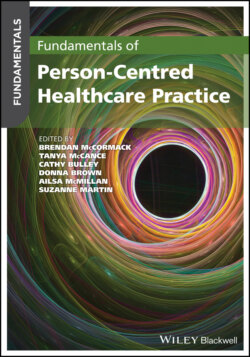Читать книгу Fundamentals of Person-Centred Healthcare Practice - Группа авторов - Страница 11
Foreword
ОглавлениеThe whole of this ground‐consolidating, forward‐looking book is far greater than the sum of its parts. Exquisitely designed and written, it builds on decades of rigorous research and scholarly inquiry in and on person‐centred practice in healthcare in the UK and around the world. Individuals, teams, workplaces and some organisations have aspired to make this practice a reality. However, in recent years, person‐centred practice has only become possible for ‘moments’ due to complex cultural and socio‐political contextual reasons that have forced nursing, for example, to go back, almost full circle, to a 21st century version of 20th century task‐focussed care. In the UK, these reasons include severe cost‐cutting in the National Health Service, resulting in a lack of resources and time to build healthcare systems that support authentic, person‐centred practice. Another reason, worldwide at this very moment, is the COVID‐19 pandemic.
Writing this foreword, therefore, has been an emotional experience for me because I have been fortunate to play a small and exciting part in a worldwide movement that has enabled health and social care professionals to become person‐centred practitioners, leaders, educators, facilitators, life‐long‐learners, practice developers and researchers. So for me, the ‘whole’ of this book that goes beyond the sum of its parts, is that it offers hope and a way for recovery towards authentic person‐centred practice, at every level of healthcare. The way in this book is a lifelong learning adventure, so the book is crafted for pre‐registration students, experienced practitioners, leaders, practice and systems innovators and all those in between. This means that we can dive into parts that are relevant to us as we become more person‐centred and progress through our careers.
At the heart of the book is the dynamic Person‐Centred Practice Framework, created and fine‐tuned by Brendan and Tanya and tested by practitioners nationally and internationally. With an aesthetic minimalism, the theoretical framework reveals the macro context, prerequisites and person‐centred processes that come together to create a desired outcome of a healthful culture in which receivers and givers of care flourish.
As if a piece of music, the book weaves the Framework through a four‐part structure that enables chapter authors to improvise their unique contribution to the whole. Concepts and constructs of the framework, set out in the first and second sections, flow and harmonise through the third and fourth that are concerned with person‐centred practice in different health and social care contexts and facilitating learning and development respectively.
There is an interactive and unifying style of writing and design used by the many authors that lifts the book above being merely a linear textbook to the musical qualities of flow and integration. For example, authors show how the Framework interconnects and fits with the approaches, concepts, models or principles relevant to their professions, roles, service users, students, colleagues, service contexts or learning environments. They also speak directly to us readers as they offer a variety of reflexive, embodied, creative and imaginative activities (alone or with others). They enable us to engage with the whole of ourselves, as we dive into relevant concepts, constructs, dilemmas and challenges of knowing self as a person and active learner and being person‐centred within a particular nuanced context. These activities are enriched by web links, clinical vignettes and discussions about what we might have uncovered. Further insights, strategies and practices are offered that we may not have reached ourselves, for instance, on how to reflect upon and re‐appraise our practices, help our learning, develop and care for ourselves and create cultures of effectiveness in our workplaces.
So just as a piece of music can jolt us into our bodies and emotions and then being still and silent to go deeper into ourselves to reflect upon what matters to us, this book jolts us to examine issues in relation to our past, current and future practices as well as our ways of active learning, knowing, being and becoming. Thus, it can help us embody or internalise the Framework in our own being and practice.
I finish with a haiku that captures the most important thing for me about this book, at this time in our world’s history. I wish you well. You are the future.
Singing the circle round
A call to action
Person‐centredness for all
Human flourishing!
Decision‐makers!
For moral healthcare systems
This book is a gift
Exemplar for all
Showing how to enculture
Person‐centredness
Angie Titchen
July 2020
